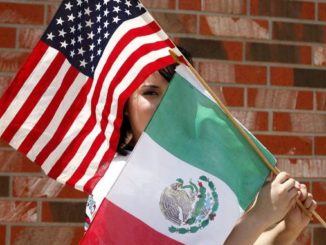
by Admin
Introduction
Since 2008, net migration from Mexico to US has been stagnant or declining. However, there are some states where the number of Mexican foreign born continues to grow. As an example, between 2010 and 2016 California showed the largest decline in net Mexican migration while Texas showed the largest growth. Analysis of wage level differentials between states introduces an interesting paradox, as average wages in California are higher than in Texas. This clearly suggests that non-wage factors may explain the positive migration trend observed in Texas.
Migration theory has established at least four determinants of net migration. First, foreign-born Mexicans may be more attracted to migrate to states in the U.S. with a higher wage level or economic growth than the national average (Hicks, 1932; Sjaastad, 1962). More generally, favorable labor market conditions (lower unemployment, more demand for labor) may increase net Mexican migration towards a specific state (Harris and Todaro, 1970; Rendon and Cuecuecha, 2010). Second, some states may have lower costs of living, which may also generate an attraction of Mexican migrants from diverse origins (Graves, 2012). More generally, differences in prices of non-tradable goods and/or provision of public goods may influence migration decisions (Mueser and Graves, 2012; Cohen, Lai and Steindel, 2014). Thirdly, there may be non-economic reasons, not related to wages or costs of living, like for example, differences in enforcement of U.S . immigration laws, that could attract more Mexican migrants to specific states (Orrenious and Zavodny, 2015, 2016). More generally, institutional factors may also affect labor markets generating market frictions and, in turn, attract or deter migrants (Harris and Todaro, 1970; Dahl, 2002; Shimer, 2007). Fourth and finally, according to Social Migrant Networks theory the existence of more migrants from specific places may lower costs of living, increase probabilities of employment or improve wages for specific migrants that belong to such specific network (Munshi, 2003; Massey et. al., 1987).
Differences in behavior between states and migrants will depend on how the four main determinants interact with individual characteristics of the foreign born Mexicans and how those factors change over time (Molloy, Smith and Wozniak, 2011). In particular, three elements can generate differences between states: first, changes in individual characteristics that are correlated with migration determinants within each group can change; second, migration incentives for specific groups can change; and third, changes in fundamental factors (i.e. wages, costs of living, etc.) for different groups can change.
Modeling net Mexican migration to the US faces different econometric challenges that arise from the dynamic nature of the migratory process and the undocumented nature of a large proportion of Mexican immigration. The dynamic nature of the immigration process implies that we may face spurious correlation, reverse causality, endogenous regression, endogenous sampling, truncated variables and omitted variable bias, as the main econometric challenges. The undocumented nature of a large proportion of the Mexican immigration also implies that measurement errors in the number of foreign-born Mexicans found in the US may affect the estimation.
The main objective of this paper is to present an empirical model that studies net Mexican migration by state, that includes different push and pull factors that have been established in the literature of internal migration in the US. At, the same time, the empirical model uses dynamic panel data set techniques that use instrumental variables to correct for the multiple econometric challenges faced by the estimation. Because of the importance of California as the top state with a foreign-born Mexican population in the year 2000, the entire empirical model is written with variable sets relative to California’s levels. This helps the estimation in at least two dimensions: first, it eliminates the effect of average U.S . inflation in all nominal variables; second, it helps reduce potential heteroskedasticity in the data, by expressing all variables as fractions of California’s values.
In this paper, we present evidence that growth in net Mexican migration towards Texas is not due to recent migrants; instead it is shown that Mexico born individuals arriving more than five years ago to other locations in the US and later on relocating inside Texas can explain the growing trend. Similarly, evidence is shown that trends vary by demographic groups defined by age, gender, education and time of arrival to the US. Specifically, it is shown that women’s migration and migration of individuals above 60 years old are the only two demographic groups with an overall growth during the period analyzed.
The empirical models show evidence that push and pull factors vary in their degree of importance also by demographic group, although some common trends are identified. First, across all age groups a negative congestion effect of the amount of Mexicans in the US is found. Second, differences in costs of living relative to California are found to reduce net Mexican migration.
The paper also finds common effects for certain specific groups. For example, a greater wage relative to California increases net migration for men, and also for College educated men and women. The effect is not positive among all women. A larger number of green card holders have a positive increase net migration for men, but not for women or the college educated between both gender groups. A larger number of individuals 60 years and older increases net migration for men, but not for women, and for the college educated among both gender groups. A larger number of children below 15 years old is found to increase net migration for women but not for men or the college educated among both gender groups.
Finally, the paper analyzes the existence of a Texas effect. As stated earlier, specific Texas effects on net migration are found to vary by demographic groups. Positive Texas effects on net migration are found for living costs and for Mexicans with 60 years and older. These results suggest that social migrant networks are stronger in Texas and that the behavior in house values, relative to California, has attracted Mexicans towards Texas.
Negative Texas effects on net Mexican migration are found for the manufacturing sector in the cases of prime age men and women. Considering the growth observed in manufacturing in Texas, this may be related to immigration enforcement in that sector. A negative effect is also found in the retail and trade sector for young individuals, which is consistent with the decline in labor demand observed in Texas in that sector. A negative effect is also found between the c cost of electricity and the increase net migration of prime age men. Finally, a negative effect is also found in the case of relative wages of prime age, college educated, recently migrated women.
This paper is the first to study Mexican net migration in Texas. Previous papers have explained declines in the groups’ US immigration. For example, Passel, Cohn and Gonzalez-Barrera (2012) have argued that the decline in migration or reversal is due to higher rates of deportation, unemployment during the 2008 recession and/or increased family reunification in Mexico. Massey (2016) and Duran (2016) argue that a reduction in population growth in Mexico explains the decline in migration while Orrenious and Zavodny (2015, 2016) argue that greater efforts to reduce undocumented entry and employment are mainly responsible for the decline; Warren (2017) claims that increased planned returns to Mexico due to improved employment opportunities in the nation explain the decline; Cuecuecha (2018) claims that stronger job and wage growth in Mexico are the main determinants; and that a medium term trend of reduction in the US-Mexico wage differentials, as well as no further deteriorations of internal wage inequality in Mexico also help explain the declining Mexican-US immigration trend (Cuecuecha, Fuentes and McLeod, forthcoming).
We organize the analysis in four parts, as follows: The first part of analysis documents differences in Mexican net migration by migrants’ length of residence in the US, education, gender and age cohort. The second part presents evidence that Mexican net migration differences across states can be explained by relative changes in wages, costs of living, and labor demand. The third section, presents an empirical model that demonstrates the importance of each of the analytical variables described above by different sub-populations of Mexicans living in the US. The last and fourth part presents the conclusions.
You can read the full paper below or download the paper “The Decline in Mexican Migration to the US: Why is Texas different?” from the SMU Texas-Mexico Center website.



